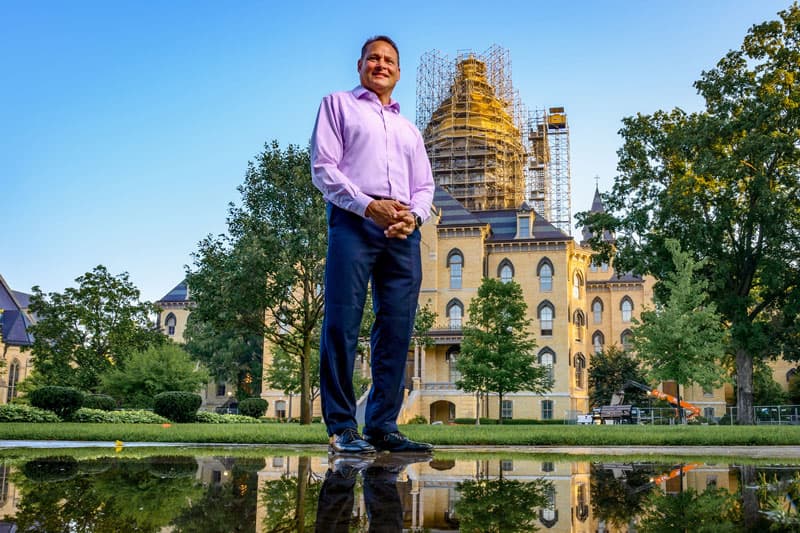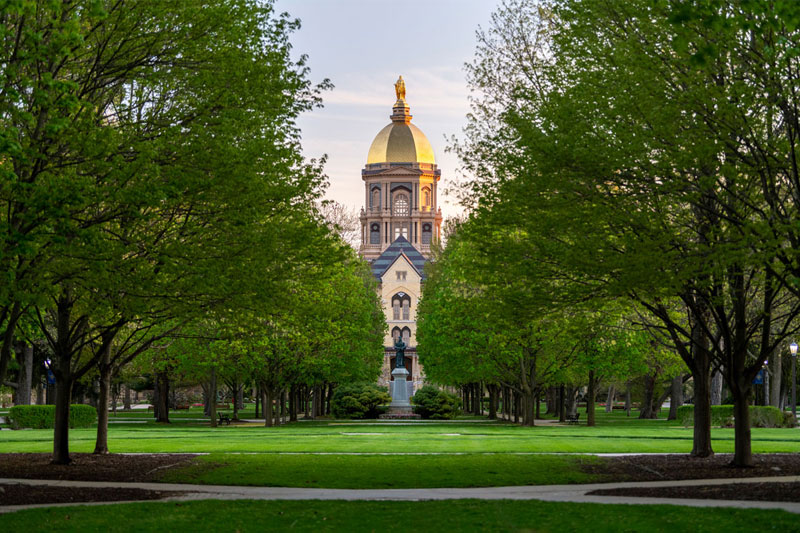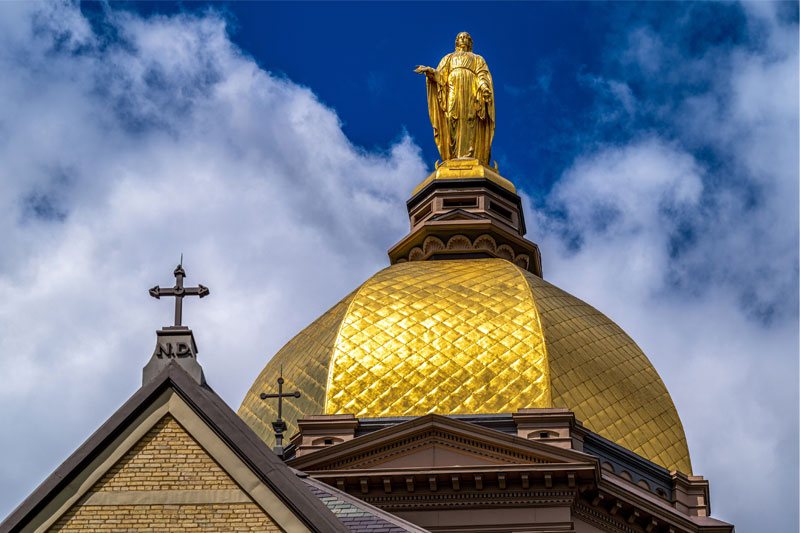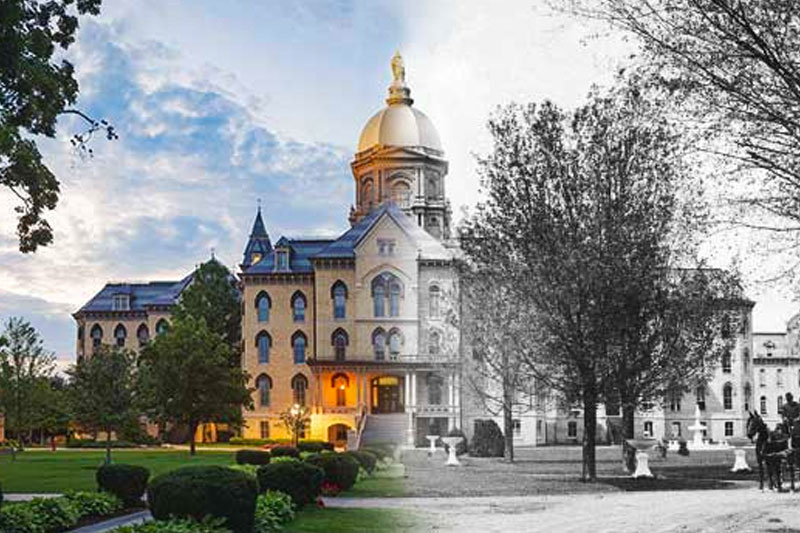It’s hard to miss the big to-do happening these days atop the Main Building. Scaffolding erected around the Golden Dome and statue of Mary signals a regilding—the act of bringing back the luster and beauty of the iconic architecture known the world over.
For many on campus, witnessing this process for the first time is a truly memorable experience. And for Tony Polotto, the senior director of construction, the sentiment is no different. Polotto has not one, but two regilds under his belt, which is impressive, given the length of time between each gilding. (The previous regilding happened 18 years ago in 2005.) Polotto brings both experience and perspective as he navigates this regilding, the 12th overall.
“I came to Notre Dame in 2003 because it is a magical place,” said Polotto. “I look forward to coming to work every day. I’m one of the fortunate people in the world that enjoys their job.”
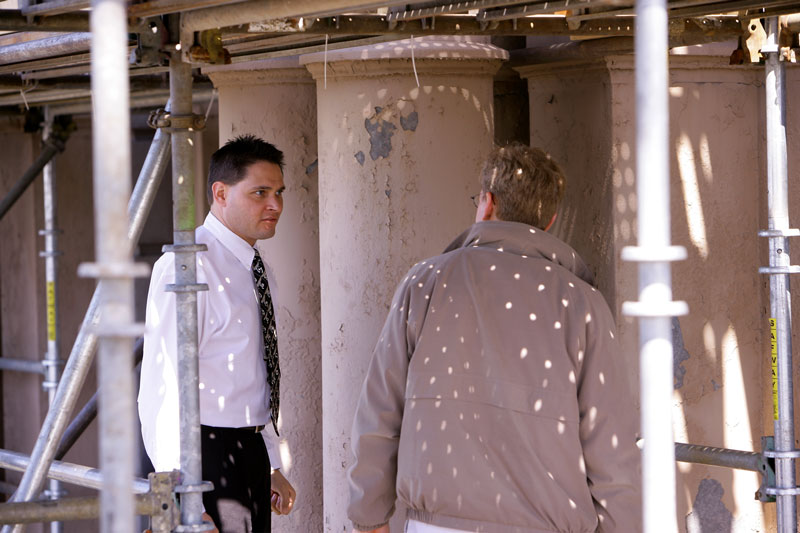
With scaffolding in place and contractors on site, Polotto led a meeting outside the Main Building with members of the campus police and fire departments, Risk Management and Safety, and the Office of Public Affairs. Attendees introduced themselves and their roles. It was July 10, and this was the beginning of something big—a once, maybe twice, possibly a three-times-in-a-lifetime event. Even so, before anything began, Polotto wanted to make it clear to all present that safety was the most important consideration. So much so that he let everyone know that if something needed to be stopped, delayed, or pushed back due to safety concerns, he would make that happen.
Polotto set the tone for what would be his second successful gilding.
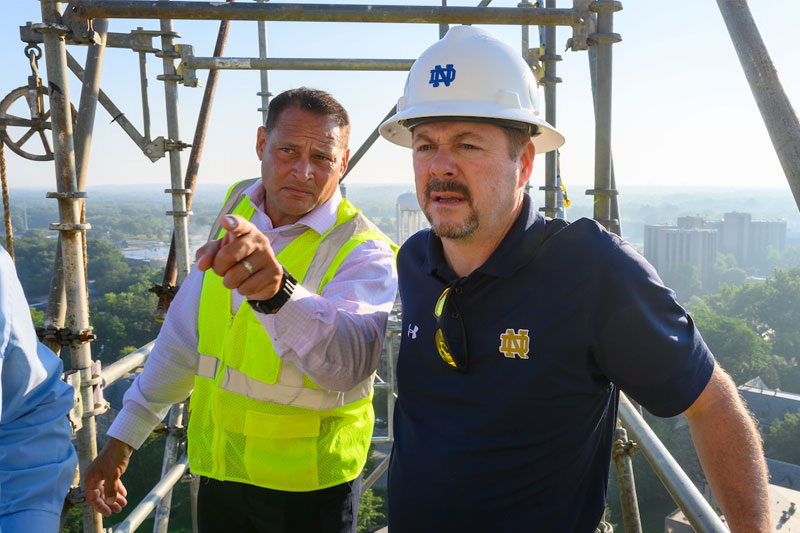
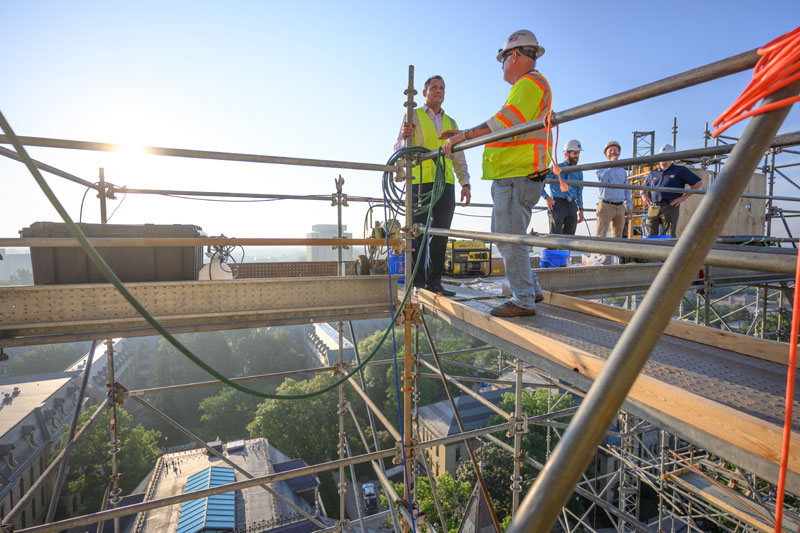
Having just celebrated 20 years at Notre Dame, Polotto has an impressive portfolio of managing building projects on campus including six new residence halls, the security and post office building, Warren Golf Course and clubhouse, Ave Maria Press, and Malloy Hall.
“Those were all substantial buildings that I can be proud of, to say I was a part of that. They’re just remarkable, beautiful structures. But the Main Building, I can say, has been my favorite project out of my career.”
Polotto has 33 years of experience in construction—working with contractors, developing relationships, working with quality assurance, and making sure the final product is what it needs to be. But it’s the everyday work and developing relationships on campus that are most meaningful for Polotto.
“The people are amazing. I wouldn’t hesitate to pick up the phone and call anybody on this campus at any level and expect a warm greeting and helpfulness. It makes my job easier. It makes this project easier and it adds to the joy and value of my career.”
The beginning
Every year Polotto uses video from a drone to assess the Dome and statue of Mary, checking for deterioration. When it starts to show wear and tear, plans for a regilding start to form.
While planning for this regild began in July 2022, the foundation was laid back in 2005, after Polotto’s first successful regilding project. Necessity and foresight led to the scraping of all layers of gold and other material off the Dome and Mary, down to the base substrate.
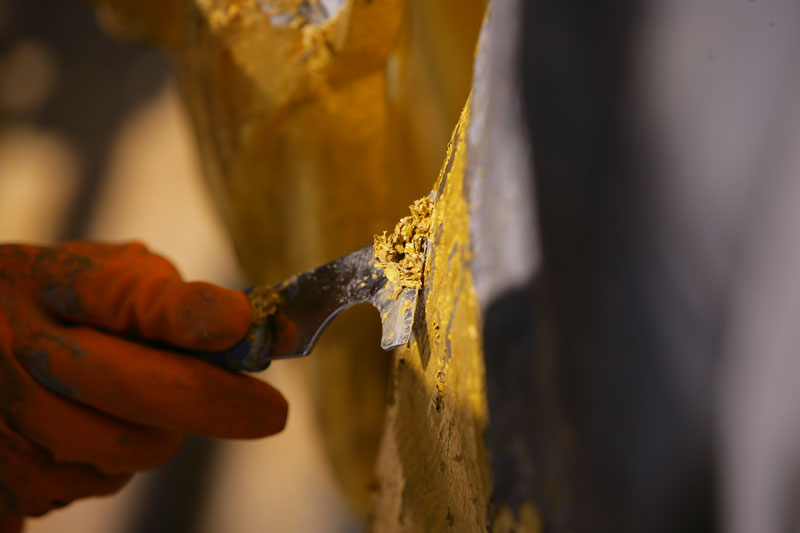
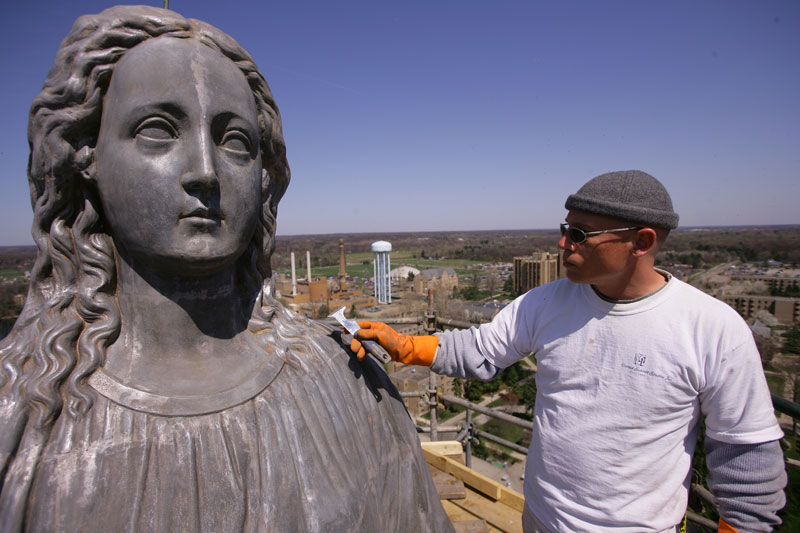
“The regilding process is not just an aesthetic feature,” Polotto explained. “It’s not a beautification of the Main Building itself. It serves as a protection for the structure.”
The Dome is made of galvanized steel panels and the statue of Mary is cast iron. It can rust, and the galvanized panels on the Dome can deteriorate without a protective coating.
“If you can imagine a home that has 10 coats of paint on it and some of it has flaked off, you know what that would look like. So, it was in pristine condition when we left it in 2005,” recalled Polotto. “Fast forward to 2023, you know, with a bit of experience from the first process, I didn’t have the anxiety as I did going into it [then]. The processes and procedures were clean and cut, but the actual job itself is very similar.”
The 2005 prep work also led to a shorter timeline and a leaner regilding team. The timeframe for completion is down at least two weeks, and the regilding team is less two people because their prep roles aren’t necessary. Basically, five people will take care of the Dome and six people will repair and repaint the tower.
Polotto did the heavy lifting at the beginning of the project—the planning, the bidding, the contract awards when they began the process in 2022. “Now that the work has started, I’m working with some real pros, right? So my oversight is just that now.”
The process
Polotto describes the 2005 renovation as a learning process. The questions he had then are equally appropriate now: “It was an experiment of what do we have to be worried about that nobody’s ever thought about before? The scaffolding is a large, complex system. We have to do a structural analysis on the building. How can we load the building? Can the building take the load? How is it going to be engineered and built so we can access all of the tower and the actual Dome and the statue of Mary?”
The scaffolding went up in May, as soon as the students left campus. Polotto’s office makes a daily inspection of the scaffolding system, planned and designed months before it is erected. This is a far cry from how it was done in the past.
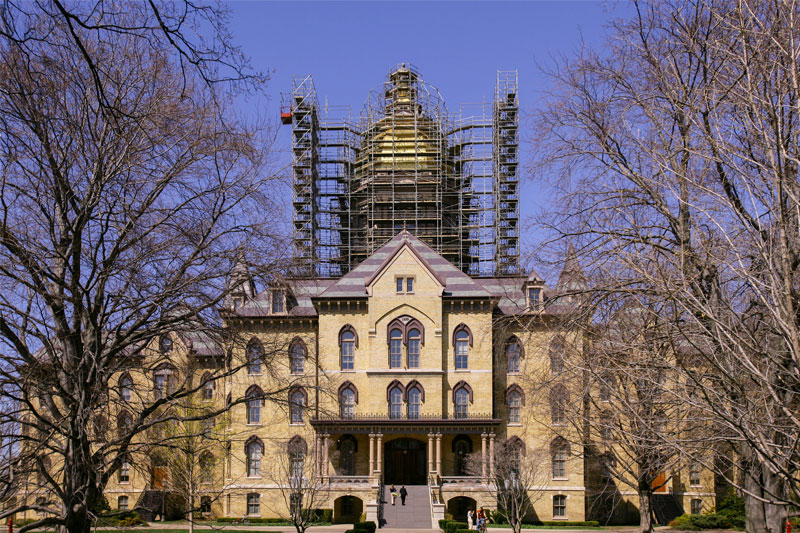
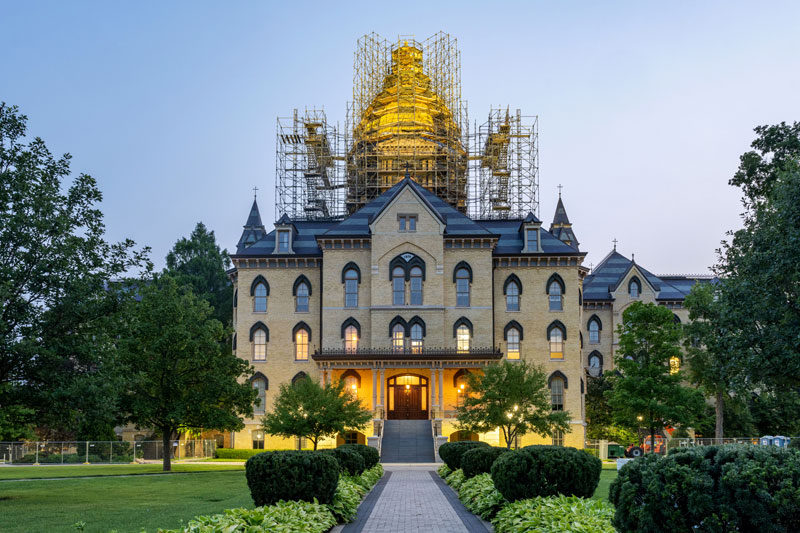
“What’s been interesting is, if you see any historic photos of the Main Building, the people that took care of this building generations ago literally climbed out small access hatches at the base of the statue and did the gilding and the repair work off of ropes swinging from the inside of the structure. That would never fly today. And that’s why we have the complicated scaffolding systems,” he explained.
Conrad Schmitt Studios, the group that did the last regilding as well as other projects on campus, returned for this one. Polotto has worked with the father, son, daughter, and granddaughter in the Schmitt family, and in a reunion of sorts, other members of the team have returned for this regilding. This includes the foreman from the 2005 regilding, who is the project manager for this go-round. The only new players are the painters, working on beautifying the tower below the Dome.
Workers use rolls of gold leaf, thinner than a strand of hair. It is adhered to the statue and Dome using first a primer or size, and then glue. The gold is rolled on and rubbed in with a cotton glove. “It looks like an automobile finish,” Polotto said. “When it’s done, you can’t see any seams or any imperfections in the gold at all. It almost looks like a sprayed finish.”
From start to finish, the restoration takes five months, including the five weeks to erect the scaffolding and the four weeks to take it down.
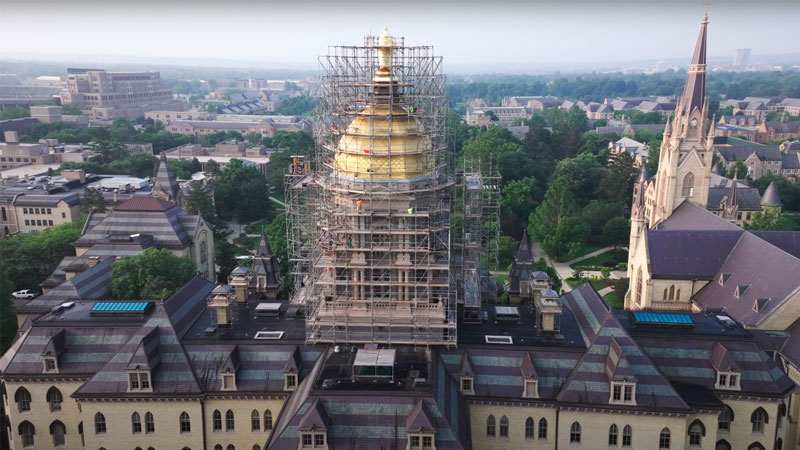
Measuring success
For Polotto, success isn’t just the final project. It’s also the process, including protecting pedestrians, visitors, faculty, staff, and workers in general.
“We have measures in place to make it a success. Are we on time? Was it done safely? And is the quality of the finished product what we want to see?” These questions are the barometer for success.
“I would say with the painting and the gliding itself, it’s not just the expertise, it’s the passion for your job,” Polotto said of the workers involved with the process. “We have one shot for doing this right, and if you go up and take a look at it, it’s done right. These people care about what they’re doing. They’re passionate about their work.”
